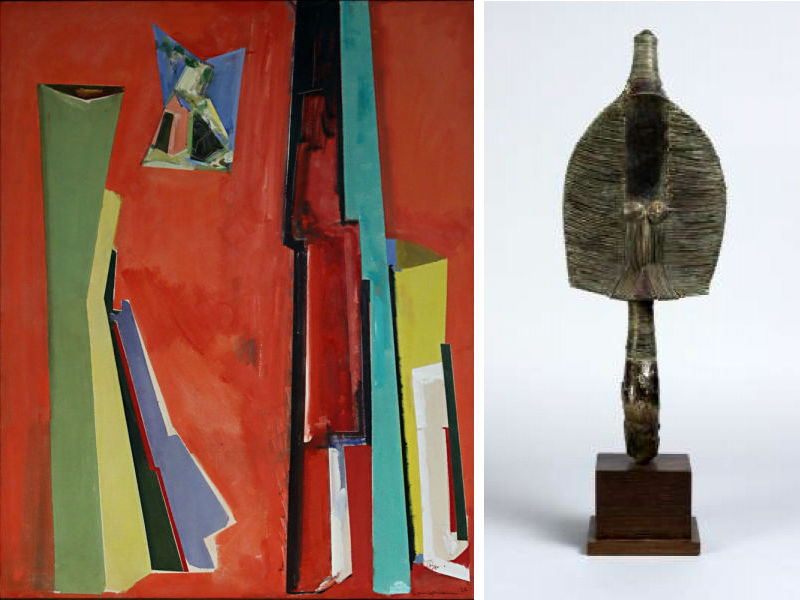UMMA's "Victors for Art: Michigan’s Alumni Collectors -- Part II: Abstraction" makes the private public

University of Michigan Museum of Art’s recently opened Victors for Art: Michigan’s Alumni Collectors -- Part II: Abstraction is the second show in a two-part series that began in February with Part I: Figuration. The exhibition includes a wide range of art, from an Amish quilt by an unknown maker to modern and contemporary works by influential artists such as Pablo Picasso, Christo, Louise Nevelson, Robert Rauschenberg, Barbara Kruger, Jasper Johns, John Baldessari, and many more.
As the title suggests, the show consists of a diverse range of works collected by University of Michigan alumni. The contributors come from 70 years of graduating classes, displaying the long-standing, continuing impact of university alumni collectors on the global art world. UMMA states that the show “offers an unprecedented opportunity to view art that may have never been publicly displayed otherwise -- and most certainly, not all together.”
The eclectic works represent over 3,500 years of art making. The criteria for the show is simply “abstraction” and “alumni collections” lending to a unique approach in which a 5th-century Korean roof tile, a work by an Inuit master, and works by critically acclaimed contemporary artists are displayed side by side. Abstraction in this exhibition is approached in a variety of ways, from abstracting the human figure, abstracting color and form, or from taking an object out of its everyday environment (see the terracotta brick affixed to the wall by Robert Arneson) and isolating it in a gallery space.
UMMA describes the varied processes of abstraction in the works on their gallery wall, offering a concise explanation of the qualities of abstract art: “Many artists use elements from the world around us … but through diverse strategies of abstraction, they transform and distil these into patterns gestures and ideals, creating compelling visual experiences through line, form, and color.”

Many works in the exhibition focus on form, color, line. Yet others, such as Lorna Simpson's hand-colored photogravure Untitled (What Should Fit Here Is an Oblique Story About Absence), conceptualizes abstraction through the inclusion of representative imagery. The work consists of two images side by side. On the left, a piano with two “feet” and on the right, two women’s shoes. Though the objects represented are “real,” they are abstracted when placed together. The work creates a commentary about gender. Under the images, a line of text reads, “What should fit here is an oblique story about absence, but I can’t remember the short version.” The inclusion of hand-tinting recalls 19th-century photographic practices, and the style of shoe included in the image on the right suggests a long-gone era. Image and text combine within this work to investigate language’s impact on meaning making, particularly in relation to photography. As UMMA’s curators state on the gallery wall, “(S)eeing does not necessarily mean believing, but rather is set up in opposition to believing.”
Two different works commented further on abstraction and the nature of art objects through their inclusion of reflective surfaces. First, Liz Deschenes’ Untitled zoetrope, a pre-film animation device that created the illusion of motion when spun.

The second work that included a reflective surface is MASTER, a 2014 work by artist Jeremy Penn. This piece is made from “vintage erotica, spray paint, and mirror-finished stainless steel on panel.” The mirror-finished stainless steel is rectangular, with a black frame. In the center of the piece, the word “MASTER” is the only matte part of the image, and within the letters the artist has placed collaged “vintage erotica” from '40s, '50s, and '60s publications. This work is part of a larger series, Evolution & Ego, in which Penn explores the “sexual gaze” through the combination of the mirrored surface and the written text. Other works in the series are identical mirrored surfaces with words such as “Gaze,” “Hunt,” “Lust,” “Prey,” “Power,” “Evolve,” “Beast,” and “Tease.” Together and alone, the words chosen for this series provoke the viewer to consider the roles of power in sexual relationships. The word choice “Master” evokes an array of unsettling power dynamics. The experience of viewing this object presents the viewer with the option to imagine him/her/their self as a “Master.” This is perhaps one of the least unsettling options from the series. Would I want to stand in front of a mirrored surface with the word “Prey” emblazoned on it and imagine myself in that space? In this way, we become aware of the implications of the array of charged words Penn selects for his works.
This exhibition is filled with works that have until now been in private collections, offering a unique opportunity to see rare and unknown artworks by some of the 20th and 21st centuries’ most celebrated artists. Stay tuned for the site-specific installation that will extend into the Irving Stenn Jr. Family Gallery beginning August 19 and running through November 26. This exhibition will include Random International’s LED-light and motion-sensing sculpture Swarm Study / II.
Elizabeth Smith is an AADL staff member and is interested in art history and visual culture.
"Victors for Art: Michigan’s Alumni Collectors -- Part II: Abstraction" runs through October 29 at UMMA's A. Alfred Taubman Gallery I. A calendar of events can be found on the UMMA website, with many exciting opportunities to participate in art-making workshops and gallery talks.


































